Insert credit: Games still struggle to credit the people who actually make them
The industry needs to get better about crediting its workers; Demonschool does it right.
Images: Necrosoft
When the hotly anticipated tactics RPG Demonschool came out earlier this month, what caught my eye the most wasn’t the vivid artstyle, the tongue-in-cheek humor, or the college setting. It was the credits. Alongside the usual list of names are a few sentences written by the game’s director Brandon Sheffield that outline exactly what Necrosoft’s team and contractors did for the game.
Thanks to these detailed credits, we know that Technical Director Shane Marks was “responsible for stitching everything together, developing and implementing underlying technologies […] and created the technique menu flow and accessibility options,” among other contributions. Similarly, Technical Audio Designer Vincent Diamante “implemented all music and sound effects and devised all sound effect and music systems.” Hayden Scott-Baron “refined minigame pacing and flow” and crucially “created fish outlines in fishing minigame” as a Designer. And so on. Without this level of depth, we could only guess what a “Designer” did on the game, as is the case with most credits.
It’s hard enough to get your name into a game you worked on, let alone have your actual contributions detailed to this extent. Many studios only credit those around at the launch of a game, regardless of the work those contracted or let go from the studio did for it during development. If you’re not around when it ships, you may as well not have been there at all. Some studios have the decency to go back and update credits if developers have changed names, but in most cases, a game’s credits stand as a monument to whoever was on the payroll at the time it shipped. What’s more, games with external partners are dependent on those partners providing their own list for the credits, with some only giving the company name.
In the past companies would even obscure credits for their internal teams, like when Capcom reduced the work of Yoko Shimomora on Street Fighter II: The World Warrior to the anonymised “Shimo-P.” This was often done to prevent their developers being poached by rival game companies, but also served to minimize their contributions and visibility—a particularly sore point in an industry where people are often assumed to be male. Atari’s reluctance to credit its developers infamously lead to Warren Robinett hiding his name within Adventure, making it one of the first easter eggs in games. Hiding names in games even became policy at publisher Atari when they saw how their players enjoyed the pursuit.







































